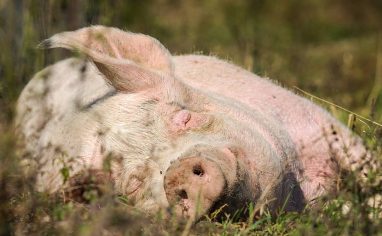
Subscribe To The Open Sanctuary Podcast
If you’d like to get the latest episodes of The Open Sanctuary Podcast, you can subscribe for free on all Podcast platforms, including Apple Podcasts and Spotify!
Episode Notes
Senior Advisor Tara and NonprofitA non-governmental organization whose primary purpose is something other than selling goods or services. Specialist Julia discuss why we should consider caring for chickens as indoor companions! Keeping chickens inside may sound strange for people outside of the sanctuary world, although more and more people are realizing that chickens can make great indoor companions. In fact, sometimes taking care of chickens indoors has been a major impetus for some folks to fully recognize the beauty of having a close relationship with chickens and changing their relationship to what they formerly considered to be “farmed animalsA species or specific breed of animal that is raised by humans for the use of their bodies or what comes from their bodies.” in life-changing ways!
Keeping chickens as indoor companions can have a number of benefits for both the birds and their caregivers. We’ll talk about those benefits in this episode and our personal experiences caring for chickens indoors.
—
This Episode’s Referenced Open Sanctuary Project Resources:
- Sharing Your Home With Chickens
- The Open Sanctuary Project’s “Indoor Chicken” Informational Brochure
- Compassionate Care Classroom Basic Chicken Care Courses
- Chickens: How We Got Here
- Basic Chicken Care Suggested Curriculum
Techniques And Practices Necessary For Responsible Chicken Care - Things That Are Toxic To Chickens
- Daily Observation For Chicken Health And Well-Being
- Introduction To Supportive Care For Chickens With Disabilities: Non-Ambulatory Residents – Part 1
- Introduction To Supportive Care For Chickens With Disabilities: Non-Ambulatory Residents – Part 2
- Introduction To Supportive Care For Chickens With Disabilities: Non-Ambulatory Residents – Part 3
- Additional Care Recommendations For Older Chickens
- Predator-Proofing For Bird Residents At Your Sanctuary
- The Care Of Chickens In Extreme Cold
- Advanced Topics In Resident Health: Avian Influenza
- Creating An Enriching Life For Chickens
- The Microsanctuary Resource Center
Episode Transcript (Auto-GeneratedThe following content was transcribed through an automated process and may contain transcription errors or misspellings.)
Julia Magnus: Greetings, Sanctuary friends and family. Today, we’re here with another episode of the Sanctuary podcast. I’m Julia Magnus, the nonprofit specialist and also bird nerd. And I’m here with my fellow bird nerd and friend and senior adviser to the Open Sanctuary Project, Tara Hess. So today, we’re excited to talk to you about a very special subject dear to our hearts, indoor chickens. For people within the sanctuary world, this is not maybe an unfamiliar concept, but for people outside of it, it may sound strange. Even though more and more, even outside the realm of sanctuary rescue and micro sanctuary, people are realizing that chickens can make great indoor companions. Tara, tell me about your experience keeping chickens indoors.
Tara Hess: My experience keeping chickens indoors, well, maybe this is just funny to me, but we have this basic chicken care course that if folks want to learn about chickens, they should check out. And when we were working on it, we were like, “Oh, we should probably make a note about caring for chickens indoors,” which I had never done. And so, I connected with a few folks who had to learn more about it. And then sure enough, within a couple weeks, a situation came up where there was a rooster at a shelter I was familiar with. I felt a responsibility to get him out of there. And I was thinking that he could be placed. And so I thought I’d foster him short-term indoors in our home. And I felt better equipped to do it, especially having talked to other folks who had done it. And then like so many things, he was not a foster and just became part of our family. So we cared for Cantaloupe in our home for maybe three years, and it was wonderful.
Julia Magnus: It is pretty wonderful. I too have cared for chickens indoors, and in fact, as a matter of fact, if you hear some light clucking in the background, that would be Highway. She is a hen who we suspect largely from her circumstances, type, and condition was a truck jumper, and she is pretty uniquely suited to being an indoor hen at the moment. So, for anyone who’s new to chickens generally, I think we probably should stress one thing that Tara mentioned, which is the chicken care course, which is available for free at the Open Sanctuary Project, as well as numerous other resources with regards to chicken care. Those would all be very, very helpful resources to review prior to caregiving for chickens, generally, whether indoor or outdoor. But yeah, we strongly suggest that you review those if you’re interested in taking on a new chicken companion. But once you get to know those basics, there’s also some other things to start considering whether your feathered friends should be indoors with you or outdoors. But why don’t we start by talking about some of the benefits of keeping them indoors. Tara, what are your thoughts on that?
Tara Hess: So the first that comes to mind is protection from the elements. So chickens need to be protected both from dangerous heat, cold, and not just protected in terms of preventing some sort of serious illness, but also kept comfortable so that they can thrive and do well, you know? So, it’s more than just preventing frostbite. You also want them to be happy and comfy. And depending on where folks live, that might be super, super challenging outdoors regardless. And by outdoors, of course, I mean that they have an indoor space that is designed for them and will keep them protected from predation, the elements, all sorts of things that they have access to. But that’s not quite the same as a human dwelling. And so for Cantaloupe, we didn’t have a chicken coop. We didn’t have any sort of thing that he could even be set up outside if we wanted him to be able to live full-time separate from our home. But having him inside, and we adopted him right before winter, having him inside, it was so nice to know that we didn’t have to worry about trying to keep him warm and not just keep him warm, but keep him warm safely because fire is such a scary thing when it comes to electric and heating devices. So, it’s such a, it can be a really tricky balance. So, that’s the first one that comes to mind. It’s just so much easier to control their environment in terms of temperature and humidity and keeping them comfortable so that they can be happy.
Julia Magnus: Yeah, that’s so true. Part of the reason that we’re always concerned about keeping their environment at consistent and safe temperatures for them is the fact that chickens are descended from red jungle fowl. So if you think about the environment of a red jungle fowl, they’re not in Minnesota winter or Chicago winter. And so they are sensitive even though over many years of domestication there may be some notions of cold-hardy breeds. That’s largely kind of a mistaken perception of chickens. All of them do require, in order to thrive and not just survive, they do require temperature control and climate control. So indoors, it really is a lot easier to provide that. What about predators?
Tara Hess: So predators are the other big one. I mean, that’s the other big thing that comes to mind because for folks who maybe haven’t checked out our resource on predator proofing or our podcast on the needs of predator protection for avian residents. Chickens are vulnerable to so many different types of predators and they need such robust protection, particularly overnight, also during the day, but especially overnight. And it’s, for folks who don’t know, I mean, it’s serious. It’s like if you have a hole that is the size of a quarter or a gap under a door, that is a potential way for a predator to come in and kill your residents. And so, I’ll go back to Cantaloupe with having Cantaloupe indoors. I had cared for chickens for a decade at a sanctuary and I would have so much stress closing everybody in for the night, checking latches, making sure everything was tight, making sure nothing had broken that I wasn’t aware of that was going to maybe allow a predator to come in. And so I never slept well on the nights that I was responsible for closing because it’s so much pressure and there’s so much that can go wrong. And I slept so soundly having Cantaloupe indoors because with it being a human dwelling, it’s not the same risks that are with a chicken-specific or, you know, some sort of other structure that houses different species. It’s just not the same. We were right here. Predators weren’t going to get in. We did have to consider when he went outside during the day, predator protection, obviously, but man, I’ve never slept so soundly caring for chickens as I did when Cantaloupe was under our roof.
Julia Magnus: Oh my goodness, I super feel that. It is so, if you are only caring for an individual or two, it is so much easier honestly to do it indoors versus building all of the infrastructure that you need to protect against predators, the elements, and making sure that that infrastructure is safe from risks of fire and other things. And another, you know, another side note, it can really also help, like if you have one or two and you’ve got humans around you, it really does kind of mitigate the risk of neighbor complaints, gripes, or potential human mischief because sometimes that happens to keep birds indoors the way that you would any other companion animalAn animal who spends regular time with humans in their home and life. Typically cats and dogs are considered companion animals, though many species of animals could also be companion animals.. I’m sitting here with Highway, and I mentioned earlier that she’s really, she’s perfect. It’s really good for her to be indoors right now. And there are a couple reasons for that. Highway when she came in to us, she has a broken coracoid bone, which is like the clavicle or shoulder. What do you call that? The human equivalent. I don’t know. I guess it’s a clavicle. Anyway, that bone is broken. So, she can’t, we really need to restrict her ability to flap or fly right now. She also was really anemic when she came in. So, they did treat her for that. But at the same time, one concern with that was maybe she had been exposed to heavy metals. So, they really wanted us to observe her closely to make sure that she wasn’t manifesting any other symptoms of that kind of toxicity. So for her, it’s really perfect for her to be indoors where I can keep my eyes on her at all times. Cantaloupe I know fell into this category as well. Do you want to tell me more about how being an indoor chicken benefited him and other kinds of individuals who might also benefit from being indoors?
Tara Hess: Yeah. So for Cantaloupe specifically, and of course we didn’t know this when we set out to foster him, but he ended up being an older gentleman. He had arthritis and suspected nerve damage that was causing some mobility issues. So that we sort of figured out early on. And so having him indoors was nice because we could give him a really cushioned surface. He didn’t have to, you know, sometimes with an outdoor setup, an indoor setup that is separate from the home is what I mean. You know, like a chicken coop, like they’re sometimes elevated for various reasons. And so then you have to figure out a safe way for residents to get in and out. Like, we didn’t have to do that. Everything was nice and flat. But the thing that I think jumps out the most for me with Cantaloupe specifically is he ended up having some really serious health issues that manifested as these really scary respiratory; he’d go into respiratory distress and they would come on suddenly and often, especially in the beginning, they would go away quickly. And all I could think was, okay, if he had been a resident at the sanctuary that I worked at, it would have been, and not even through the fault of anyone, it would have been so easy to miss. You would have had to been there right when it happened and you could have been there 5 minutes before and been like, “He looked great.” And or 5 minutes after and be like, “He’s quiet, but he’s mostly okay.” And you would have missed what was going on. But because he was in our home and also because I work from home, so I’m here a lot. And this was also during the height of the pandemic. We were home all the time. I heard everything. So, I heard the first little gurgle. I heard the first little wheeze and I could go check and I could record and I could communicate. So, I was able to gather so much more information about his situation to share with the vet because again, just like a caregiverSomeone who provides daily care, specifically for animal residents at an animal sanctuary, shelter, or rescue. could have missed it in a setting where they were coming and going because he had his own space that you were entering for whatever reason, and then you left. When you bring someone to the vet, like obviously there are things they can look for, but sometimes your predominant concern if it’s not showing up when they’re at the vet, sometimes the vet is just relying on the information you had and they’re sort of at a loss. And so that happened with Cantaloupe a little bit where he would go to the vet and sometimes be okay. But I had all this information that I had gathered. One particular thing that happened because he lived with us and he was with us all the time. So like when they’re right there. I was constantly finding ways to incorporate him into the activities that were going on because he’s right there and he wants to hang out. So, we had a ritual where every night our whole family sat together and my husband and my daughter would be doing video games, and Cantaloupe and I would be sitting together and he really liked between his wattles petAn animal who spends regular time with humans in their home and life for companionship or human pleasure. Typically a small subset of animal species are considered to be pets by the general public., and he’d get right up, like he’d get right up in your face and be like, “Pet me!” And so I would pet him, and for a long time it was fine. And then one day I started to do it and I noticed that he turned purple the second I touched him. And I thought it was a coincidence, like maybe I’m just getting him excited from being pet. And then each day I was noticing that no, he wants me to pet him, he’s coming right up like he used to, but I can’t do it because it’s making him purple. And when I brought him to the vet and I explained like he’s becoming cyanotic when I touch him right here, because the vets were like, “He looks okay, you know, his lungs sound okay, heart sounds okay, everything seems okay.” And so I told them that story and they called me back and they were like, “It’s the darnest thing. We touched him where you told us and he was cyanotic instantly.” And I was like, “Uh-huh, like I told you,” you know, but like I would have never had the opportunity to gather that information if he wasn’t just always with me. So it’s really good from both the lens of the chickens and also the lens of the caregivers because you’re going to be alerted to anything that needs attention pretty quickly when you live with them directly.
Julia Magnus: Mhm. So, it’s beneficial to chickens with disabilities like Highway. Hildy was another one I had who she came in with a broken leg and was in a cast. So, there’s no question she was, she was not going to be outdoorsing around on that cast. Having her indoors was a huge benefit while she was healing from that. And Highway who is currently lying down basking in a sunbeam is going to benefit from being indoors. But it’s also so good for us and for our veterinarians to have this opportunity for a close observation and we can effectively and efficiently gather information this way so much more easily than if they were outdoors. As a side note, we do have resources on both older chickens and disabled chickens at Open Sanctuary. We’ll put those in the show notes as well. But let’s talk about this from a movement lens for a second because as you and I both know, there is an endless need for homes for farmed animals in need, in chickens specifically and often roosters. I want to give a big shout out to the Micro Sanctuary Resource Center, which is a resource that supports micro sanctuaries in lots of different ways. So, please go check them out. We’ll also note them in the show notes. But from a movement lens, if you care for one or two chickens indoors, you are creating more opportunities for chickens to find homes.
Tara Hess: Totally. And that’s really meaningful and even if you can’t do it full-time, if you can’t take one on lifelong, you could do it as a foster potentially to try it out and see what living with a chicken is like. And in fact, our colleague Amber Barnes who has done that on two different occasions. She cared for a hen who was left at her house when she purchased a house, and she cared for a rooster, Rocco. And as another side note on observation, she, when Rocco developed a hoarse crow, she was quickly able to hear that and bring him to the vet and that was a great benefit to him, and obviously it helped him find a forever home ultimately. So from a movement lens, it also seems helpful.
Julia Magnus: Yeah, I totally agree because it is, I mean you know this better than I. It’s hard to find placement when you compare it to the need. And so, the more homes, the more compassionate homes that are available, obviously that is a win for the birds. And I’ll also say, because like I said, we set out to foster Cantaloupe, but knowing that indoor chickens were a thing and was a possibility, even though I had never done it before. I had cared for chickens, but I had never brought a chicken into my home. But knowing that it was a possibility, when I found out about Cantaloupe, it was, “We need to go get him.” I knew I needed to get him out of that shelter because I knew that they were very good at certain things but weren’t equipped to care for chickens, and I knew that where he was the chances of him finding appropriate placement were slim. Now, if I didn’t know that indoor chickens were a possibility, but because I do know the things that chickens need, I would have thought, “I can’t help other than maybe finding someone else who can take him because I don’t have a coop. I can’t go out and get a coop. I don’t have somewhere to put him.” And then long-term too, I would have thought, “Well, he doesn’t have any, I don’t have any other chickens. He doesn’t have friends.” That’s another major benefit of having them indoors. If you’re in a situation where someone is home a lot is companionship is so important for chickens and some of them it really does have to be other chickens, but not for everybody. For some, maybe they don’t get along with other chickens. Maybe they have a health reason that like Cantaloupe couldn’t be with other chickens because when he got excited, it became really hard for him to breathe. So, there were a variety of reasons why being at a sanctuary where he was outdoors with other chickens wasn’t going to be an option. But, he was not lacking in the companionship department because he had three humans who doted on him and spent like every waking moment with him. Like, he really was only alone overnight when he was in his comfy little bedroom. So, from a movement perspective, so yeah, it gets more people involved and then also, and I’m sure you can speak to this, it brings chickens into spaces and community circles that they might not otherwise be in. That’s so, so true. I think a lot of people don’t really, there’s just some sort of bias against considering farmed animals in general, and chickens in particular, as indoor companions. Like it’s a shocker for a lot of people to think about, but when they see it, they’re like, “Whoa, this makes perfect sense.” Seeing the chicken bounce up onto the couch and like dust bathe on their fleece blanky next to you while you’re watching TV. They’re like, “Well, that’s amazing. This is something that I’d be interested in looking at.” So, you normalize the treatment of these animals in this fashion as companions, as beloved companions who live indoors with you and share your life, your day-to-day life with you. And I think that’s invaluable from a movement perspective. You know, I’m a huge fan of Micro Sanctuary. I have one, and I’m a huge fan of the Micro Sanctuary Resource Center for continually forwarding these ideas about how you can care for animals in this fashion. It’s wonderful. And frankly, let’s be real. And this is a tangent for sure, but it’s one that’s important. Chickens are much more appropriate indoor companions for humans than are parrots. Yet, for some reason, parrots are celebrated and viewed as status symbols or something to, I don’t know, put on a pedestal. Whereas, they can do significant damage to humans. They require significant amounts of care that are well past the realm of what most people are able to provide. And chickens cannot do the damage to you that a parrot can. Chickens are far quieter and they’re domesticatedAdapted over time (as by selective breeding) from a wild or natural state to life in close association with and to the benefit of humans. Parrots are wild, and they are far more suited to sharing your home than a parrot would be. So, if you’re interested in bird companionship, you will get all the joys of living with a bird if you bring in a chicken versus adopting a parrot. And you will do a good service for the chickens with and you show people that this is a legitimate way to live with them and care for them.
Tara Hess: Yeah, I think I told you this, but I feel compelled to share it again. But, you know, it’s not just within the movement of getting more people involved and considering how we care for chickens, but it also, it just gives you so many opportunities to connect with folks who don’t think about chickens at all or have a lot of misconceptions about chickens to see them in a new light and then maybe question some stereotypes that they didn’t realize they were buying into. So for Cantaloupe, because he had this chronic illness, he needed medication that I picked up at a human pharmacy and, you know, it was this whole thing where I had to be like, “It’s under Cantaloupe. What’s the species? He’s a chicken. He’s a chicken,” you know, like this whole thing. And so it was funny, because after he had been getting medicine from this pharmacy for a long time, but I had probably only been picking it up versus having it delivered for a few months. But still, I feel like they were starting to recognize me and be like, “Oh, it’s the person with the chicken.” And so one day the person at the counter was like, “I just have to ask, like what’s going on with Cantaloupe? Like, who is he? Why does he need these meds?” So I explained and I was like, “He lives at our house”.
Julia Magnus: He lives in your house?
Tara Hess: Yes. And like, “How does that work?” And so I showed them a picture on my phone of him cuddled up next to me on a chair, like essentially like you would picture a cat, you know, all curled up. And they were just, they were floored. And of course, they thought that he was beautiful and adorable and that it was so sweet. And I just, you know, I could only hope that that would make them start to wonder like, are all chickens maybe? Like, should I think differently about chickens? You know? So it just gives you, yeah, I just feel like it opens up a lot of doors for planting some seeds.
Julia Magnus: I totally, I totally agree. I have actually had that same experience with pharmacies, and actually we’ve had folks come in, like to service the furnace or something, like they’re like, “What is…”.
Tara Hess: Yes, “What is?!”.
Julia Magnus: And I’m like, “Oh yeah, that’s just, that’s whoever it happens to be, that’s Hildy or that’s Blizzard or that’s Highway or that’s…” And they’re like, “This is amazing. I didn’t know you could do this.” And it’s so, it’s great because they’re like, “Huh, maybe I should do this.” I’m like, “Yeah, you totally should. I’ve got plenty who need them. You want? I’ve got choices for you, friend. You could pick any kind of chicken”.
Tara Hess: Yeah. So, it’s, I feel like it’s a really big warm fuzzy for me in this work to talk about indoor chickens. So, I really.
Julia Magnus: I really enjoyed this discussion. And me too. So, in this discussion, we kind of cover, you know, why are we doing this? Why care for chickens indoors? And so we kind of covered some of the benefits, how it can be in certain contexts way easier to do than your traditional chicken keeping setup, talked about how it’s helpful from a movement basis. And then in the future, we’re going to do a part two to this podcast. And in that series, we’re going to talk about practical considerations for caring for chickens indoors because yes, it may be easier in some senses, but there are some things that you’ll have to think about and address, and we’ll cover those, and we look forward to talking to you then.

Got A Podcast Idea? Contact Us!
If you have a topic or question you’d love to hear our staff address on The Open Sanctuary Podcast, please get in touch via our contact form!






